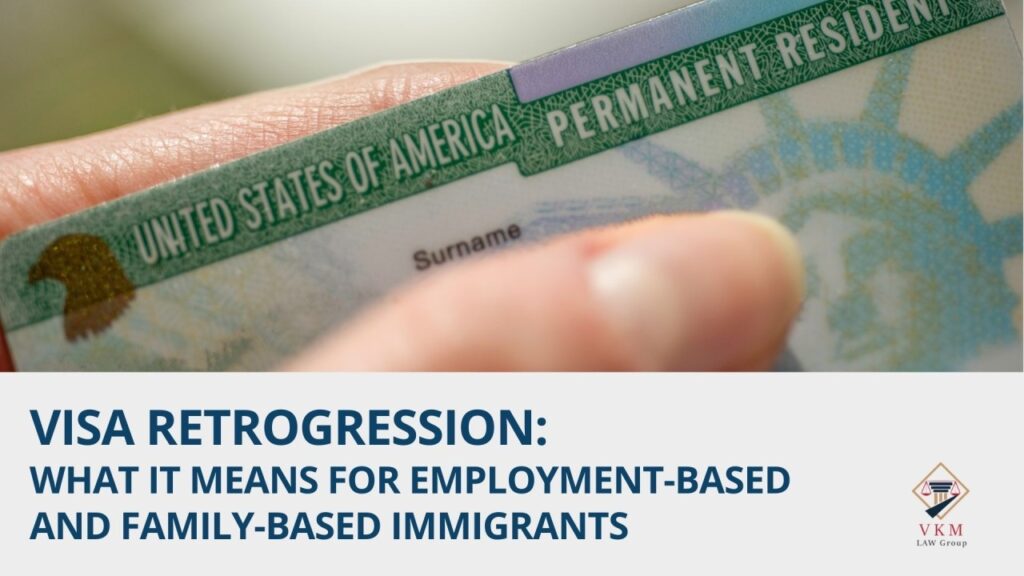
Visa retrogression is a frustrating reality for many immigrants waiting for their green cards. If you’ve been following the Visa Bulletin and noticed that your priority date is no longer current, you may be wondering what this means for your case.
In this blog, we’ll break down what visa retrogression is, why it happens, and how it impacts employment-based and family-based immigrants. We’ll also explore strategies to navigate these delays and explain how an immigration attorney can help you stay on track.
What Is Visa Retrogression?
Visa retrogression occurs when the demand for immigrant visas exceeds the supply, causing the priority dates for certain green card categories to move backward instead of forward.
In simple terms, if your priority date was “current” in a previous Visa Bulletin but then moves backward in the next bulletin, your case is now on hold until your priority date becomes current again.
Retrogression affects employment-based (EB) visas and family-sponsored (F) visas, creating longer wait times for individuals hoping to obtain permanent residency in the U.S.
How DOS Estimates Visa Availability
The U.S. Department of State (DOS) determines visa availability each month based on several factors:
✔️ Annual visa limits: U.S. immigration law caps the number of green cards issued per category each fiscal year. ✔️ Per-country limits: No single country can receive more than 7% of the total visas issued each year, leading to backlogs for high-demand countries like India, China, Mexico, and the Philippines. ✔️ Processing trends: DOS considers how many applicants are actively pursuing their visas, how many cases are likely to be approved, and how many dependents will receive green cards along with the primary applicant.
If demand is higher than expected, the DOS adjusts the cutoff dates in the Visa Bulletin, sometimes moving them backward—causing visa retrogression.
Why Does Demand Exceed Supply?
Several factors contribute to visa retrogression, including:
🔹 High application volumes – Some green card categories receive thousands of applications per month, quickly exceeding the available supply. 🔹 Unused visas from previous years – Unused visas don’t always roll over to the next year, leading to inefficiencies in the system. 🔹 Per-country caps – Countries like India and China have significantly more applicants than the 7% cap allows, resulting in multi-year (or even decades-long) wait times. 🔹 Policy changes and USCIS processing delays – Government policies, administrative delays, or sudden surges in demand (such as during COVID-related policy changes) can impact visa availability.
How Does Visa Retrogression Impact Green Card Applicants?
When visa retrogression happens, applicants may face several challenges:
📌 Longer wait times – If your priority date moves backward, you must wait until it becomes current again before proceeding with your green card application. 📌 Work and travel restrictions – If you’re adjusting status in the U.S., you may face delays in getting a work permit (EAD) or travel document (Advance Parole). 📌 H-1B and other nonimmigrant visa extensions – If your green card is delayed, you may need to extend your nonimmigrant visa status to continue working in the U.S. 📌 Uncertainty for families – Family-based immigrants, especially those in the F2A category (spouses and minor children of green card holders), may experience delays that separate them from loved ones.
Strategies to Handle Visa Retrogression
Although visa retrogression is frustrating, there are ways to manage it:
✅ Check the Visa Bulletin Regularly – Keep track of the monthly updates from the Department of State to see how priority dates are shifting.
✅ Maintain Your Legal Status – If you’re in the U.S. on a temporary visa (such as H-1B, L-1, or F-1), ensure that you renew your status as needed while waiting for your green card.
✅ Explore Alternative Visa Categories – Some applicants may qualify for other green card categories, such as the EB-1 (for extraordinary ability professionals) or EB-2 National Interest Waiver (NIW).
✅ Upgrade to a Faster Category – If you have an approved EB-3 petition and meet the qualifications for EB-2, you may be able to request an interfiling to switch categories and get a faster priority date.
✅ Consider Consular Processing – If you are eligible, consular processing may be an alternative to adjustment of status, depending on the wait times for your visa category.
✅ Apply for Work Permits and Travel Documents – If you are applying for a green card from within the U.S., ensure that you apply for Employment Authorization Documents (EAD) and Advance Parole (AP) to avoid work and travel restrictions.
How an Immigration Attorney Can Help
Navigating visa retrogression can be complex, but working with an experienced immigration attorney can help you:
🔹 Understand your visa category and wait times – An attorney can analyze your case and determine the best strategy for minimizing delays. 🔹 Explore faster alternatives – If you qualify for an employment-based or family-based green card category with a shorter wait time, an attorney can guide you through the process. 🔹 Ensure compliance with visa requirements – Maintaining legal status while waiting for a green card is crucial, and an attorney can help you with renewals, extensions, and status changes. 🔹 Prepare for interviews and documentation requests – USCIS and consular interviews require extensive documentation. An attorney can help ensure your case is as strong as possible. 🔹 Handle RFEs and denials – If you receive a Request for Evidence (RFE) or a denial, an immigration lawyer can help you respond effectively or file an appeal.
Visa retrogression in 2024 is affecting thousands of employment-based and family-based immigrants. While delays are frustrating, understanding why they happen and knowing how to navigate them can help you stay prepared.
If you or a loved one are affected by visa retrogression, VKM Law Group is here to guide you through the process. Contact us today to discuss your options and get expert legal assistance in navigating the U.S. immigration system.